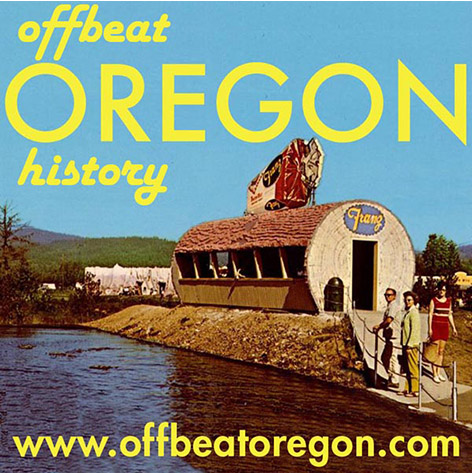CONTINUED FROM THE PRINT EDITION:
Deadliest natural flash flood was in Heppner
And it looked like they were going to get it. As the afternoon wore on, heavy clouds started forming in the hills south of town. Then, a little after 4:30 p.m., the skies started opening up, and the first drops of rain came down on the little town. Lightning flashed. 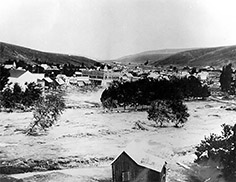
The Heppner flood as it appeared after the main crest of the floodwaters had receded. The brick building in the center is the Fair Building. (Image: Heppner Gazette-Times)Half an hour later came hail — big rough chunks of ice plummeting out of the sky, clear ice lumps the size of chestnuts, big enough to really hurt when they hit you. Residents scurried inside to escape the pounding. The hail continued hammering down on the town, making a tremendous racket. This had a lot to do with why the flood was so deadly — not only were almost all Heppner residents in their houses when it happened, but the thunderous rattle of the falling hailstones masked the roar of the wall of muddy water, trees, boards, cattle, sheep, and other flotsam when it arrived, a few minutes later, at their village.
Most of the water ended up in the headwaters of the Balm Fork of Willow Creek, but the main fork of Willow Creek got lots as well. Balm Fork merges into the main stem of Willow Creek just upstream from Heppner. Most summers, the water there is ankle deep. 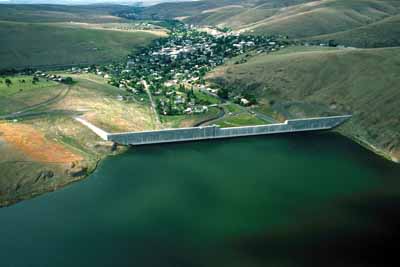
Heppner as it appears today, in an aerial photo from above the Willow Creek Dam — which, despite its ominous appearance, protects the town from the very disaster it appears to threaten in this photo. (Image: Army Corps of Engineers)On this occasion, though, the water coming down Balm Fork was probably ten feet high if not more. As the water had run down the canyon, debris had clogged every fence and bridge across the creekbed and held back the flood for a second or two while more water poured in and piled up. By the time it reached Willow Creek the crest was an enormous slug of water just thundering down the mountain. Witnesses compared it to a barrel rolling down the hill, thick with flotsam and debris. It hit Willow Creek with full force, gouging a brand-new cove in the opposite bank of the creek. The swirling delayed the flood more; more water rushed in. The slug of water got even bigger. Then it rolled into Heppner. The first thing it met in Heppner was a new steam laundry built cantilevered over Willow Creek at the upstream end. This laundry was stout and well built, and it held the water dammed up for a few more seconds before giving way and releasing the water into the town. By that time the wall of water was taller than the houses it was slamming into. Eyewitnesses gave estimates of between 30 and 50 feet. A few people saw what was happening in time to do something. One heroic man jumped on his horse and set out hell-for-leather downstream through town, shouting a warning to the people in the houses: “Flood! Run to the hills! Flood! Run to the hills!” It’s extremely unlikely this man, or these men (there may have been two), survived the flood, as the water would have chased them down before they could reach the city limits. Also, no one today knows who they were. But a number of survivors credit their shouted warning with saving their lives.
|
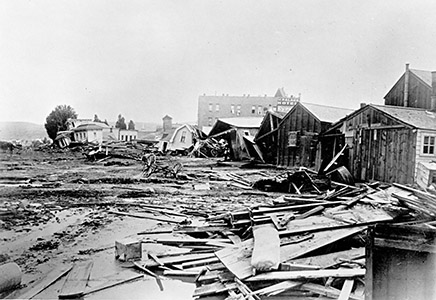
Those who did not hear or heed this warning were apt to find themselves being carried downstream inside their houses, crushed by collapsing timbers or drowned in filth. Among those who were caught in the torrent, survivors were few. One lucky family rode downstream in their submerged house, up to their necks in water, and were able to escape when it fetched up against another structure. But for the most part, those caught in the flood drowned or were crushed as their houses were carried away and broken apart by the awesome hydraulic force.
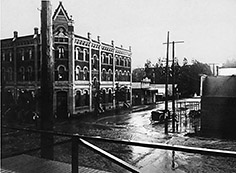
This eerie photo of Main and May streets was taken less than two minutes before the wall of water swept through, showing the minor flooding that preceded it. By the time photographer Bert Sigsbee took this photo, the flood was already killing people on the other side of town. The large brick building is the Palace Hotel. (Image: UW Press)They had to stop to cut their way through several fences, which slowed them down; and they got to Lexington a few minutes after the water did. Luckily, it wasn’t hailing in Lexington, so the residents heard the water coming and got out of the way. They passed the crest on the way to Ione, though, and got the warning out. Nobody in either downstream town was killed in the flood. But the floodwaters contaminated every well they flowed over, and caused an outbreak of typhoid fever that killed at least 18 more people over the following month or two.
Residents of nearby towns and cities flocked to Heppner with food and manpower as well as financial contributions. A kitty passed in Portland swelled up to such a large sum that the residents of Heppner asked them to keep part of it and set it aside for the next emergency. But Heppner needed the help. It was a horrible recovery job, especially because babies and toddlers made up a significant proportion of the dead. You can imagine what it must have been like to be a survivor or a volunteer from a nearby town, approaching a collapsed wall of a demolished house, lifting it up and praying there’s not another dead baby underneath it. Today, nearly a century and a quarter later, the debris is gone and the damage long since repaired or cleaned up. But you can still see the effects of the flood with a stroll through the Heppner cemetery, located on a hill above the town. On headstone after headstone you’ll find carved, with chilling insistence, the same date of death: June 14, 1903.
|

